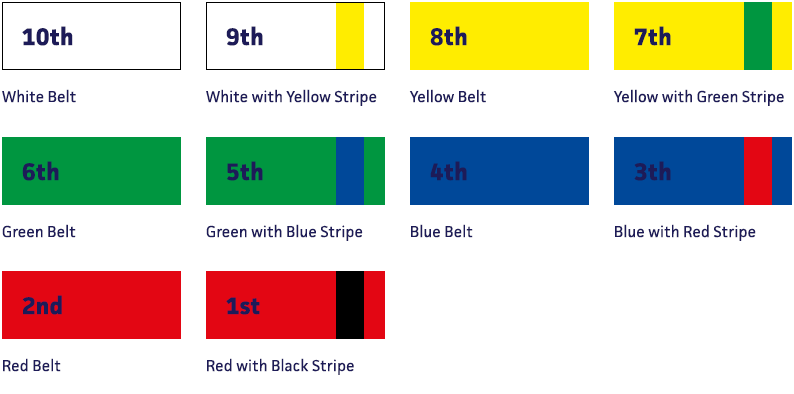The Martial Art
If there is a difference between taekwondo as a sport, and taekwondo as an art, it is that the art recognises no rules for combat while the sport of taekwondo is highly regulated for the safety of its participants.
As an art, taekwondo focuses on a combination of combat techniques and self-defense as well as being a good form of exercise and enjoyment.
In taekwondo a system of attacking and defensive movements incorporating punching, kicking and blocking techniques as well as differing stances is done in a set sequence and is referred to as Poomsae. These basic movements bring together all the martial art skills in a graceful yet powerful manner.
Poomsae forms a significant part of the promotion process in taekwondo, and practitioners must be able to demonstrate a good understanding of the arrangements before that can progress to the next rank.
Belts and promotion
Like many martial arts, taekwondo has ranks called ‘Kup’. The grading in taekwondo consists mainly of patterns, ‘poomsae’, techniques and theory. Theory is displayed verbally and expresses information on Korean words, vital information such as the rules of the sport and a general understanding and knowledge of taekwondo.
New students begin at 10th Kup (white belt) and advance down in number to 1st Kup. students then advance into an intermediate rank called meaning “black belt candidate”. After this the student takes a dan test, after which the student becomes a 1st dan black belt.
Kup ranks and belt colours
The coloured belt system represents the progression of a student from white, the innocence of a beginner to the maturity of the black belt, who is impervious to darkness and fear. The coloured belt sequence from white to black is as follows:
10th Kup White Belt – 9th Kup Yellow tag – 8th Kup Yellow belt – 7th Kup Green tag – 6th Kup Green belt – 5th Kup Blue tag – 4th Kup Blue belt – 3rd Kup Red tag – 2nd Kup Red belt – 1st Kup Black tag – Poom/Dan Black belt
Black belt – Dan ranks
Dan ranks increase from 1st Dan to 10th Dan, generally a dan black belt is either a plain black belt or has a stripe across the tip for each rank usually gold. For example, a 5th dan could have five gold stripes across the end of the belt.
All British Taekwondo members receive ranks of 1st dan and above issued from the Kukkiwon. To participate in the Olympic Games all black belt must be registered this way.
Taekwondo teaches more than just physical fighting skills and defensive techniques. It is a discipline that shows ways of enhancing our spirit and life through training our body and mind.
Please refer to the health benefits section for further information.
The Sport
Taekwondo first appeared in the Olympics as a demonstration sport at the 1988 Seoul Olympic Games. It is now also a Commonwealth Games sport.
It made its debut as an official Olympic sport at the 2000 Sydney Olympic Games. Since then it has also featured in Athens 2004 and Beijing 2008 and is one of the 26 sports in the London 2012 Olympic Games.
Taekwondo is certainly not limited to those in superb physical condition. Anyone can take advantage of its benefits when learning proper techniques.
The Match, The Rules
Taekwondo is characterised by the use of powerful kicks. Using the legs allows athletes to have a greater reach and power to disable the opponent from a distance. In sparring, turning and back kicks are most often used.
The competition is fought on a Contest Area that measures 8 m × 8 m with a safety area of at least 2 m around the Contest Area.
The contestants wear a red or blue trunk protector (hogu) and head protector, a groin guard, forearm guards, shin guards, hand protectors, and a mouth protector.
The duration of the contest is non-stop three rounds of two minutes each, with a one-minute rest period between rounds. In case of a draw after the completion of the third round, a fourth round of two minutes will be conducted as the ‘golden point’ overtime round.
In the event of a tied score, after the golden point round, the judging officials decide the match based on the initiative shown during the final round.
Foot techniques are only allowed by using the parts of the foot below the ankle bone. No shin or knee techniques are permitted.
Hand techniques only score with the front of the first two knuckles of the closed hand (fist), and only with the leading part of the hand.
Full force attack by fist and foot techniques is permitted on the areas covered by the trunk protector.
Only foot technique attacks to any part of the head are allowed. Hand techniques to the head are prohibited.
Points are awarded when permitted techniques deliver force. (Doesn’t have to be full force. Accurate and powerful, yes, but a balance of the two.) Points are awarded through the PSS electronic scoring system, with judges adding for a spin or back kick. Points are therefore awarded as follows:
- One point for foot or fist attack that strikes trunk protector (fist awarded by corner judges).
- Three points for spinning or back kick that strikes the body.
- Three points for kick to the head
- Four points for a spinning kick to the head
- A player is declared winner if the referee stops the contest.
Two types of penalties may be assigned for prohibited acts, ‘kyong-go’ (warning penalty) and ‘gam-jum’ (deduction penalty). Two ‘kyong-go’ deduct one point and a ‘gam-jum’ deducts one full point.
Although only sparring is contested in the Olympics, breaking, poomsae and self-defense are also key parts of the martial art of taekwondo and contested frequently in other competitions.
Click below for a breakdown of weight categories:
